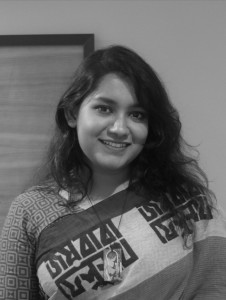
Miftahul Jannat Rasna (on study leave)
(Lecturer)Department of Electrical and Electronic Engineering
Short Biography:
I am currently pursuing my PhD in the Department of Electrical Engineering at Princeton University, United States. My research is to design and fabricate micro-scale devices on silicon wafer capable of sorting blood cells based on their physical properties. The technique is known as Deterministic Lateral Displacement (DLD); I make ...
Read more
| Degree Name | Group/Major Subject | Board/Institute | Country | Passing Year |
|---|---|---|---|---|
| Masters | Electrical and Electronic Engineering | University of Dhaka |
| Title | Organization | Location | From Date | To Date |
|---|---|---|---|---|
| Graduate Research | Princeton University | United States | 01, Feb 2019 | Currently Working |
| Teaching | University of Dhaka | Dhaka, Bangladesh | 26, Apr 2016 | 31-07-2018 |
Research Interest
| Subject | Description | Research Interest (Goal, Target Indicator) |
|---|---|---|
| Microfluidics |
Project/Research Supervision
| Level of Study | Title | Supervisor | Co-Supervisor(s) | Name of Student(s) | Area of Research | Current Completion |
|---|---|---|---|---|---|---|
| No project/research supervision is found | ||||||
Project/Research Work
| Subject | Project Name | Source of Fund | From Date | To Date | Collaboration |
|---|---|---|---|---|---|
| Fabrication of blood cell-sorting devices | Microfluidics; Cell sorting; Deterministic Lateral Displacement Arrays; Microfabrication; | 01-09-2020 | |||
| Dual-Comb Absorption Spectroscopy; Machine Learning; Statistical Modeling | Statistical modeling and theoretical performance analysis of QCL-based Dual-Comb Absorption Spectroscopic System | DARPA, USA | 01-02-2019 | 31-08-2020 |
Invited Talk
| SL | Invited Talk |
|---|---|
| No invited talk is found | |
| SL | Collaboration & Membership Name | Type | Membership Year | Expire Year |
|---|---|---|---|---|
| No Collaboration & Membership is found | ||||
| Journal Article | |
|---|---|
| 1 |
Swapnil Sayan Saha, Shafizur Rahman, Miftahul Jannat Rasna, Tarek Bin Zahid, AKM Mahfuzul Islam and Md Atiqur Rahman Ahad : Feature Extraction, Performance Analysis and System Design using the DU Mobility Dataset,
IEEE Access , vol.6 , pp.44776-44786 , 2018
.
|
| Conference Proceedings | |
| 1 |
Miftahul Jannat Rasna, Chu Teng, Jonas Westberg and Gerard Wysocki "Theoretical Performance Analysis of QCL-Based Dual Comb Spectroscopic System for Trace Detection of Chemicals in Air."
CLEO: Applications and Technology, 2020
, pp. ATu3I. 5. Optical Society of America, 2020
.
|
| 2 |
Swapnil Sayan Saha, Shafizur Rahman, Miftahul Jannat Rasna, Tahera Hossain, Sozo Inoue and Md Atiqur Rahman Ahad "Supervised and Neural Classifiers for Locomotion Analysis."
Proceedings of the 2018 ACM International Joint Conference and 2018 International Symposium on Pervasive and Ubiquitous Computing and Wearable Computers
, pp. 1563-1570. ACM, 2018
.
|
| Award Type | Title | Year | Country | Description |
|---|---|---|---|---|
| International | Wu Fellowship | 2018 | United States | |
| National | Dean' s Award | 2014 | Bangladesh |
Miftahul Jannat Rasna (on study leave)
Lecturer
Department of Electrical and Electronic Engineering
Faculty of Engineering and Technology
Email: rasna@du.ac.bd